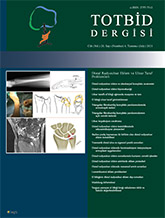
Distal radioulnar joint (DRUJ) is a synovial joint formed by the sigmoid notch of the radius and the head of the ulna, and is responsible for the rotational movements of the forearm. The effect of the bony structures on joint stability is limited and DRUJ`s main stabilizer is the DRU ligaments. Distal radioulnar joint instability, which can develop due to traumatic or non-traumatic reasons, may cause pain, limitation of forearm rotation and decrease in grip strength in patients. The diagnosis and treatment of DRUJ instability is a challenging issue for physicians. In the diagnosis of DRUJ instability, careful physical examination, provocative tests and radiological evaluation are important. As a result of recent studies on DRUJ anatomy and biomechanics, salvage procedures such as ulnar head resection have been replaced by ligament reconstructions where joint anatomy and functions can be restored as close to normal for the treatment of DRUJ instability. Non-anatomical ligament reconstruction methods can be listed as tethering distal radius and ulna with tendon grafts, stabilizing the distal ulna with tenodesis, or reconstruction of the ulnocarpal ligament. Anatomic ligament reconstruction methods, in which volar and dorsal radioulnar ligaments are reconstructed to their anatomic attachment sites, can yield results that are close to normal kinematics. As a result of advances in wrist arthroscopy, arthroscopic-assisted anatomical ligament reconstructions can be performed.